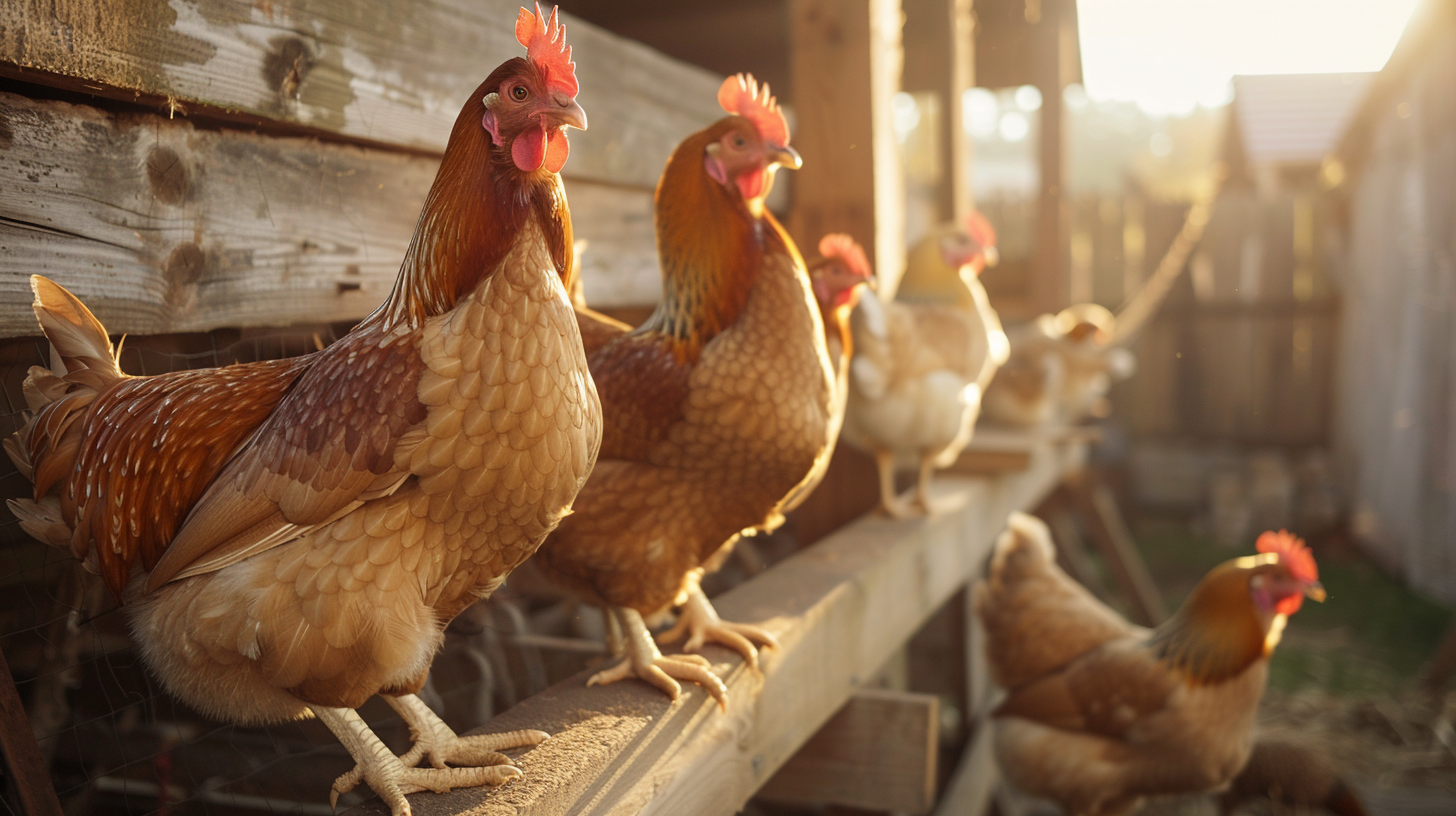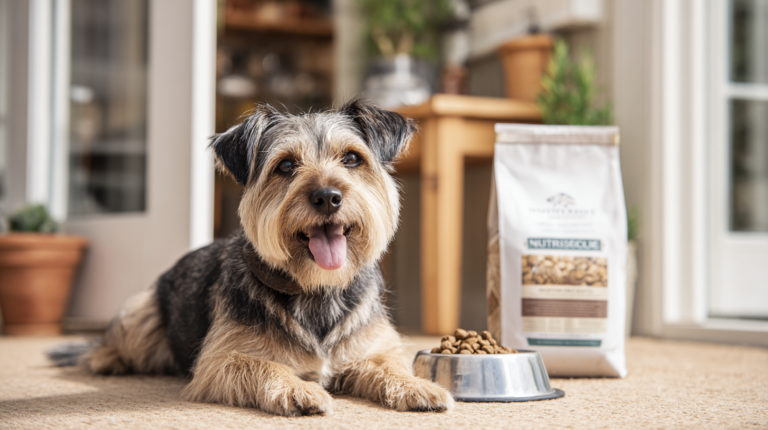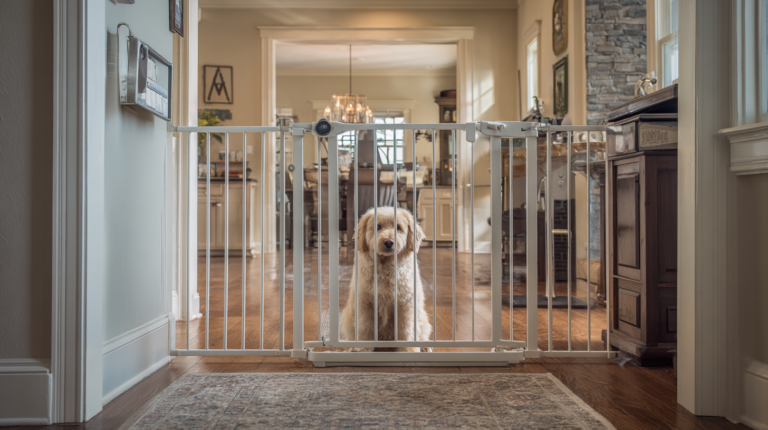Learn how to train chickens to roost properly with 3 proven methods. Expert tips, troubleshooting guide, and essential roosting bar setup for healthier hens.
Table of Contents
Are your chickens sleeping on the coop floor instead of perching safely on their roosting bars? You’re not alone. Many backyard chicken keepers struggle with this common behavioral challenge that can impact their flock’s health and safety. Learning how to train chickens to roost properly is essential for maintaining happy, healthy birds and ensuring they develop natural sleeping habits that protect them from predators and ground-dwelling parasites.
Proper roosting behavior isn’t just about convenience—it’s a fundamental aspect of chicken welfare. When chickens roost correctly, they’re safer from nocturnal predators, less likely to develop respiratory issues from sleeping in damp bedding, and maintain better overall hygiene. In this comprehensive guide, we’ll explore three proven methods to train chickens to roost, troubleshoot common issues, and create the perfect roosting environment for your feathered friends.
Understanding Why Chickens Need to Roost

Before diving into training methods, it’s crucial to understand why roosting is so important for chickens. In the wild, chickens naturally seek elevated perches at night to avoid ground predators like foxes, raccoons, and snakes. This instinctive behavior has been ingrained in domestic chickens for thousands of years, yet sometimes our coop-raised birds need gentle guidance to develop this habit.
According to poultry science research from the University of California Agricultural Extension, chickens that roost properly show 40% fewer instances of respiratory infections compared to those that sleep on coop floors. This significant health benefit occurs because elevated roosting keeps birds away from ammonia buildup and moisture accumulation at ground level.
The Science Behind Roosting Behavior
Chickens have a natural “locking mechanism” in their feet that allows them to grip perches securely while sleeping. When a chicken bends its legs to perch, tendons automatically tighten around the roosting bar, preventing them from falling during sleep. This remarkable adaptation makes roosting not only possible but comfortable for extended periods.
The ideal roosting setup mimics what chickens would choose in nature: sturdy branches positioned 2-4 feet off the ground, with enough space for each bird to comfortably perch without crowding. Understanding these natural preferences forms the foundation for successful roost training.
Method 1: The Gradual Height Progression Technique
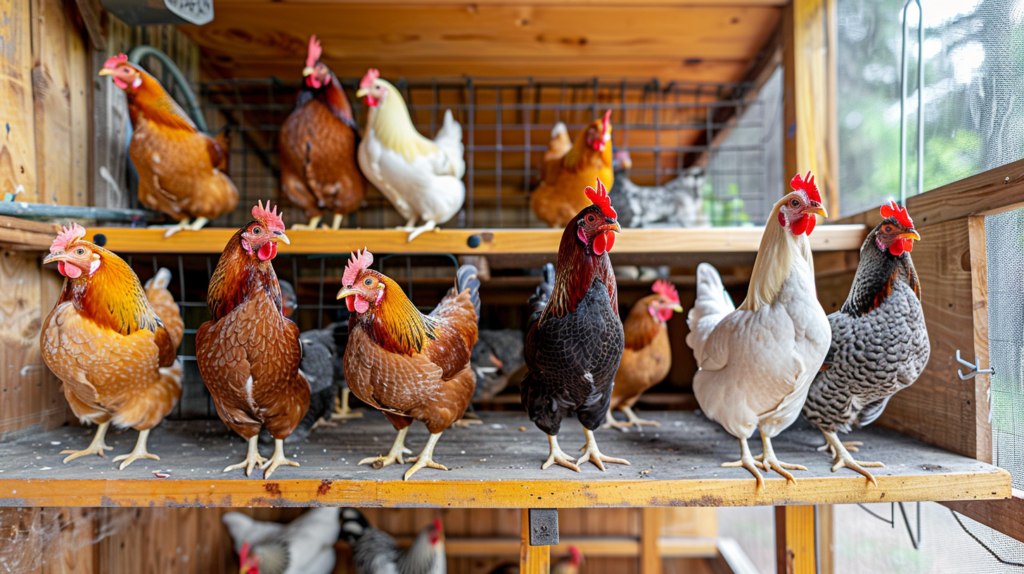
The gradual height progression technique is one of the most effective ways to train chickens to roost, especially for young birds or those who have never learned proper roosting behavior. This method works by slowly introducing chickens to elevated perches, starting low and gradually increasing height as they become comfortable.
Step-by-Step Implementation
Week 1: Ground Level Introduction Start by placing a low perch or sturdy branch directly on the coop floor. This allows chickens to investigate and become familiar with the perching surface without any fear of height. Many chickens will naturally hop onto these ground-level perches during the day, building confidence for nighttime roosting.
Week 2: Slight Elevation Raise the perch 6-8 inches off the ground. At this height, chickens can easily hop on and off while still feeling secure. Place the perch near a wall or corner where birds naturally congregate, as chickens prefer roosting in areas that feel protected.
Week 3: Standard Roosting Height Elevate the perch to its final height of 2-3 feet. Most chickens will naturally progress to this height after becoming comfortable with lower elevations. For larger breeds like Jersey Giants or Brahmas, consider stopping at 18-24 inches to accommodate their size and jumping ability.
Visual Guide to Perch Progression
| Week | Height | Chicken Behavior | Success Indicators |
| 1 | Ground level | Investigative, cautious | Birds hop on during day |
| 2 | 6-8 inches | Growing confidence | Some nighttime roosting |
| 3 | 2-3 feet | Natural roosting | Consistent night perching |
Troubleshooting Common Issues
If chickens refuse to progress to higher perches, consider these adjustments:
- Perch Material: Ensure the roosting bar has the right diameter (2-4 inches) and surface texture. Natural wood branches with bark provide better grip than smooth lumber.
- Spacing: Allow 8-12 inches of perch space per bird to prevent overcrowding and pecking order disputes.
- Location: Position perches away from windows and doors where drafts might make birds uncomfortable.
Method 2: The Gentle Manual Placement Approach
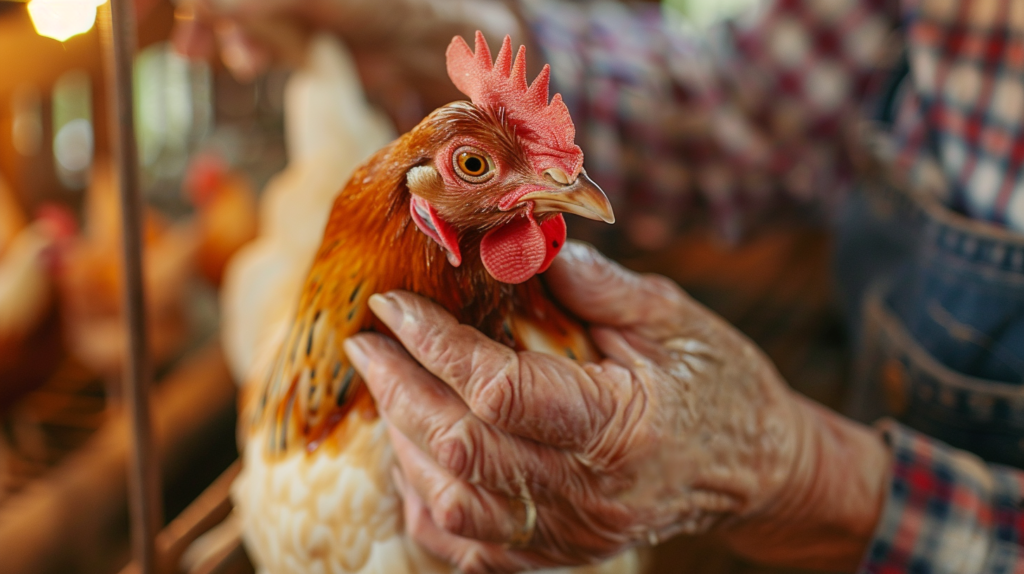
The manual placement method involves physically placing chickens on their roosts each evening until they develop the habit independently. This hands-on approach works particularly well for docile breeds and chickens that are comfortable with human handling.
Implementing Manual Placement Training
Evening Routine Setup Establish a consistent evening routine 30-60 minutes before sunset. Chickens respond well to predictable schedules, and this timing allows them to settle on roosts while still having enough light to see their surroundings clearly.
Proper Lifting Technique When lifting chickens onto roosts, use gentle but confident movements. Support the bird’s body with one hand under the breast and the other supporting the back near the tail. Avoid grabbing chickens by their wings or neck, as this can cause stress and injury.
Gradual Independence Building Start by placing all chickens on roosts nightly for one week. During the second week, place only the chickens that aren’t naturally roosting. By the third week, most birds should begin seeking out the roosts independently as the habit becomes established.
Success Stories from Professional Poultry Keepers
Lisa Henderson, a certified poultry specialist from Oregon State University Extension, reports that the manual placement method shows an 85% success rate within three weeks when combined with consistent timing and proper roost setup. “The key is patience and consistency,” Henderson notes. “Chickens are creatures of habit, and once they associate evening time with roosting, the behavior becomes automatic.”
Managing Flock Dynamics During Training
When using manual placement, be aware of pecking order dynamics. Dominant birds may attempt to claim the best roosting spots, potentially pushing subordinate chickens back to the floor. Address this by:
- Providing multiple roosting bars at the same height
- Ensuring adequate perch length for all birds
- Placing more aggressive birds on roosts first, allowing gentler chickens to find spots without confrontation
Method 3: The Environmental Modification Strategy
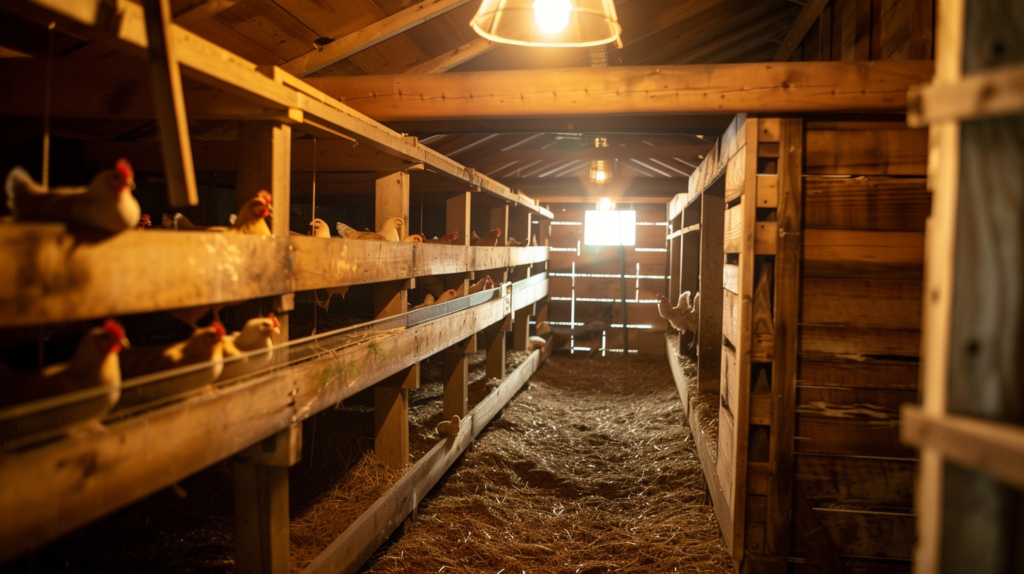
Environmental modification involves making the coop floor less appealing while enhancing the attractiveness of roosting areas. This method leverages chickens’ natural preferences and instincts to encourage proper roosting behavior.
Making the Floor Less Appealing
Remove Comfort Items Temporarily remove soft bedding, nesting boxes accessible from the floor, and any cozy corners where chickens might prefer to sleep. This creates a less comfortable ground-level environment that naturally encourages birds to seek elevated perches.
Strategic Lighting Install a red-tinted light near roosting bars while keeping floor areas dimmer. Chickens can see red light but it doesn’t disrupt their natural circadian rhythms like white light. This subtle illumination helps birds locate roosts in low-light conditions.
Temperature Gradient Creation Since warm air rises, roosting areas naturally stay warmer than floor level. You can enhance this effect by ensuring proper coop ventilation that creates a noticeable temperature difference between ground and roost levels.
Enhancing Roost Appeal
Comfort Modifications Add thin strips of rubber or carpet to roosting bars for better grip and comfort. This is particularly helpful for older chickens or breeds with feathered feet that may struggle with smooth perches.
Multiple Perch Options Provide roosting bars at slightly different heights (2-3 feet range) to accommodate chickens’ preferences and pecking order dynamics. Some birds prefer higher perches, while others feel more secure at moderate heights.
Natural Branch Integration If possible, incorporate natural tree branches of appropriate diameter into your roosting setup. The irregular surface and natural feel appeal to chickens’ wild instincts and provide better foot exercise than uniform lumber.
Advanced Environmental Techniques
Predator Scent Deterrent Placing harmless predator scent (like used cat litter) near ground level can encourage chickens to seek higher, safer sleeping spots. This method works particularly well for chickens that have previously experienced predator pressure.
Social Modeling If you have experienced roosting chickens, use them as teachers for new or reluctant birds. Chickens learn through observation, and seeing established flock members on roosts encourages similar behavior in newcomers.
Creating the Perfect Roosting Environment
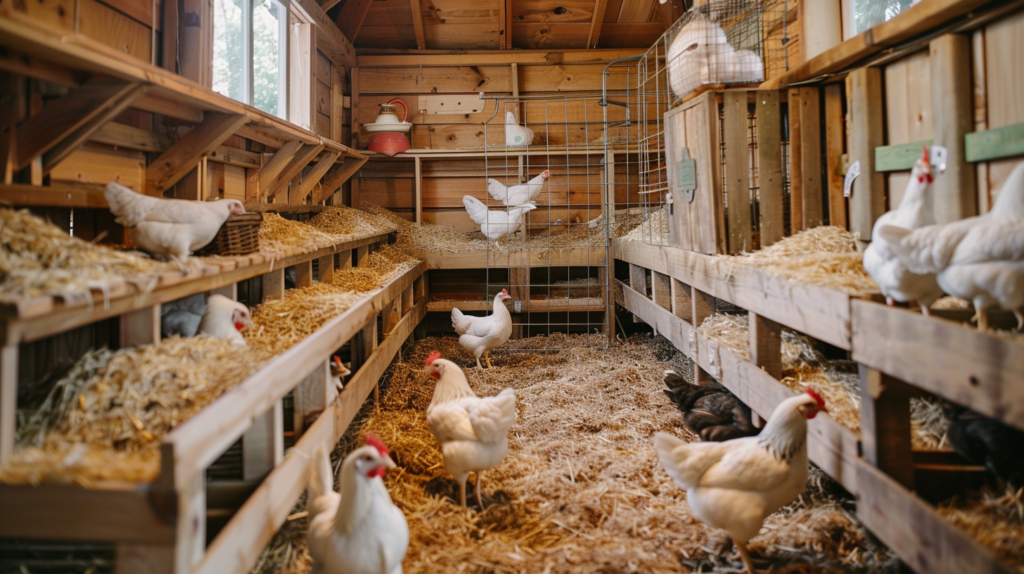
The success of any training method depends heavily on having an optimal roosting setup. A well-designed roosting area makes training easier and ensures long-term success in maintaining proper roosting behavior.
Roosting Bar Specifications
Diameter and Shape The ideal roosting bar diameter ranges from 2-4 inches, allowing chickens to wrap their toes comfortably around the perch. Rectangular bars positioned with the 2-inch side up work well, as do natural branches within this size range.
Material Selection Natural wood provides the best grip and temperature regulation. Avoid metal bars, which become uncomfortably cold in winter and hot in summer. Pine or fir lumber works well, but cedar should be avoided due to potential respiratory irritation from its oils.
Height Considerations Position main roosting bars 2-3 feet off the ground for most breeds. Bantam chickens can roost successfully at 18 inches, while larger breeds may prefer slightly lower perches to reduce stress on their joints when jumping down.
Spacing and Layout Guidelines
Horizontal Spacing Allow 8-12 inches of linear roosting space per bird. Overcrowding leads to stress, fighting, and some chickens being pushed off roosts. It’s better to have too much space than too little.
Vertical Spacing If installing multiple roosting levels, maintain at least 18 inches between bars to prevent upper-level chickens from soiling those below. Consider a ladder-step arrangement rather than directly stacked perches.
Wall Clearance Position roosts at least 12 inches from coop walls to allow adequate air circulation and prevent chickens from being cornered by aggressive flock mates.
Ventilation and Climate Control
Proper roosting areas require adequate ventilation without creating drafts directly on sleeping birds. Install ventilation openings above roost level to allow moisture and ammonia to escape while maintaining comfortable temperatures for roosting chickens.
Common Roosting Problems and Solutions
Even with proper training methods, chicken keepers may encounter specific roosting challenges. Understanding these common issues and their solutions helps ensure long-term success in maintaining proper roosting behavior.
Chickens Sleeping in Nesting Boxes
This common problem occurs when nesting boxes are more appealing than roosting bars. Chickens may find boxes cozier or more secure, but sleeping in nesting boxes leads to soiled eggs and potential health issues.
Solutions:
- Block access to nesting boxes 1-2 hours before roosting time
- Remove or reduce bedding in nesting boxes temporarily
- Install slanted tops on nesting boxes to make them uncomfortable for roosting
- Ensure roosting bars are positioned higher than nesting boxes
Pecking Order Disputes on Roosts
Dominant chickens may prevent subordinate birds from accessing roosting bars, leading to some chickens sleeping on the floor or in inappropriate locations.
Management Strategies:
- Provide multiple roosting areas at the same height
- Increase total roosting space to reduce competition
- Use separate roosting areas for different groups if necessary
- Consider removing overly aggressive birds temporarily during training
Seasonal Roosting Challenges
Weather changes can disrupt established roosting patterns. Cold weather may make chickens reluctant to leave warm floor areas, while hot weather might make elevated roosts uncomfortable.
Seasonal Adaptations:
- Add supplemental heating near roosts in extreme cold
- Improve ventilation during hot weather
- Adjust roosting bar materials for seasonal comfort
- Modify lighting schedules to accommodate changing daylight hours
Health Benefits of Proper Roosting
Training chickens to roost properly provides numerous health advantages that extend beyond basic comfort and safety. Understanding these benefits reinforces the importance of investing time and effort in roosting training.
Respiratory Health Improvements
Chickens that roost properly experience significantly fewer respiratory issues compared to floor-sleeping birds. Ground-level air in coops contains higher concentrations of ammonia from decomposing manure, dust particles, and moisture that can irritate sensitive respiratory systems.
A study published in the Journal of Applied Poultry Research found that chickens roosting at appropriate heights showed 45% fewer instances of respiratory distress symptoms, including coughing, wheezing, and nasal discharge. This improvement translates to better overall health, improved egg production, and reduced veterinary costs.
Parasite Prevention
Many common chicken parasites, including mites, lice, and internal worms, thrive in ground-level environments where moisture and organic matter accumulate. Roosting chickens have significantly less contact with these parasite-rich areas, leading to lower infestation rates.
Additionally, chickens that roost properly are less likely to engage in ground-level behaviors that increase parasite exposure, such as dust bathing in contaminated areas or pecking at infected manure.
Joint and Foot Health
Contrary to common concerns, proper roosting actually benefits chicken joint and foot health. The natural gripping action required for perching exercises foot muscles and maintains joint flexibility. Chickens that never roost may develop weakened feet and leg muscles over time.
The locking mechanism in chickens’ feet is designed for extended perching, making roosting a comfortable, natural position that doesn’t strain their musculoskeletal system when roosts are properly designed and positioned.
Advanced Training Techniques for Difficult Cases
Some chickens may resist standard training methods due to age, breed characteristics, or previous negative experiences. Advanced techniques can help overcome these challenges and establish proper roosting behavior in even the most stubborn birds.
Breed-Specific Considerations
Certain chicken breeds may require modified training approaches based on their physical characteristics and temperament.
Heavy Breeds (Jersey Giants, Cochins, Brahmas):
- Use lower roosting bars (18-24 inches) to reduce jumping stress
- Provide wider perches (4+ inches) for better stability
- Install ramps or ladder steps to assist with access
- Allow longer training periods due to reduced agility
Silkies and Feathered-Foot Breeds:
- Ensure roosts have excellent grip surfaces
- Check regularly for feather-related perching difficulties
- Consider slightly lower roost heights for safety
- Monitor for balance issues related to limited vision from head feathers
Flighty Breeds (Leghorns, Anconas):
- Use gradual introduction methods to prevent stress
- Ensure roosting areas feel secure and enclosed
- Avoid sudden movements during training sessions
- Provide multiple escape routes from roosting areas
Rehabilitation for Previously Floor-Sleeping Chickens
Older chickens or rescue birds that have never learned to roost may require patient, specialized training approaches.
Assessment Phase: Begin by observing the chicken’s physical capabilities, temperament, and any signs of previous trauma or negative experiences with elevated areas. Some rescue chickens may have developed fears of heights due to poor previous housing conditions.
Confidence Building: Start with extremely gradual height progression, potentially beginning with perches only 2-3 inches off the ground. Focus on building positive associations with elevated surfaces through treats and gentle encouragement.
Physical Conditioning: Chickens that have never roosted may have underdeveloped leg and foot muscles. Encourage natural perching behaviors during the day by providing various elevated surfaces for exploration and exercise.
Creating a Roosting Training Schedule
Consistency is crucial for successful roost training. A structured schedule helps establish routines and ensures steady progress toward proper roosting behavior.
Daily Training Timeline
Week 1-2: Foundation Building
- 5:00 PM: Check roosting setup and make any necessary adjustments
- 6:00 PM: Begin directing chickens toward roosting area
- Sunset – 30 minutes: Start manual placement if using that method
- 30 minutes after sunset: Final check to ensure all birds are properly positioned
Week 3-4: Independence Development
- 5:30 PM: Monitor natural roosting behavior
- 6:00 PM: Assist only chickens not moving toward roosts independently
- Sunset: Minimal intervention, allowing chickens to self-roost
- After sunset: Quick check for any birds needing assistance
Week 5+: Maintenance Phase
- Evening: Casual observation of roosting behavior
- Weekly: Check roost condition and make any needed repairs
- Monthly: Assess overall flock roosting success and address any new issues
Progress Tracking Methods
Maintaining records of training progress helps identify successful techniques and areas needing adjustment.
Daily Observation Log:
- Number of chickens roosting independently
- Weather conditions affecting roosting behavior
- Any issues or conflicts observed
- Time required for all birds to roost properly
Weekly Progress Assessment:
- Percentage of flock roosting correctly
- Reduction in manual intervention needed
- Overall flock comfort and stress levels
- Any emerging challenges or problems
Seasonal Roosting Considerations
Roosting behavior and requirements change throughout the year, requiring adjustments to training methods and roost setup to maintain consistent success.
Winter Roosting Adaptations
Cold weather creates unique roosting challenges that may disrupt established patterns. Chickens naturally huddle together for warmth, which can lead to overcrowding on preferred perches and some birds being displaced to the floor.
Cold Weather Modifications:
- Increase roosting space to accommodate huddling behavior
- Add supplemental bedding below roosts for safety in case of falls
- Consider wider perches that allow chickens to cover their feet with body feathers
- Monitor for frostbite on combs and wattles of roosting birds
- Deep Litter Management: During winter, deep litter methods may raise floor levels, effectively reducing roosting height. Adjust perch positions as needed to maintain proper elevation above the litter level.
- Summer Roosting Adjustments
- Hot weather can make roosting areas uncomfortable, particularly in coops with poor ventilation. Chickens may abandon roosts for cooler floor areas if roosting spaces become too warm.
- Heat Management Strategies:
- Improve ventilation around roosting areas
- Consider relocating roosts away from direct sunlight
- Provide shade over outdoor runs to reduce overall coop temperature
- Install fans or natural ventilation to improve air circulation
- For more expert pet care tips and product recommendations, visit BlithePet.com — your trusted source for pet wellness.
Frequently Asked Questions
- How long does it typically take to train chickens to roost properly?
- Most chickens learn to roost consistently within 2-4 weeks with proper training methods. Young chickens (under 16 weeks) typically adapt faster than older birds that have established floor-sleeping habits. Factors affecting training time include breed, individual temperament, roost setup quality, and consistency of training efforts. Some chickens may begin roosting within a few days, while others may require 6-8 weeks of patient training.
- What’s the ideal height for chicken roosting bars?
- The optimal roosting bar height is 2-3 feet for most standard chicken breeds. Bantam chickens can roost successfully at 18-24 inches, while heavy breeds like Jersey Giants may prefer lower perches at 18-30 inches to reduce stress on their joints. The key is ensuring chickens can easily access the roost while feeling secure from ground predators. Avoid placing roosts higher than 4 feet, as this increases injury risk when chickens jump down.
- Why do my chickens prefer sleeping in nesting boxes instead of on roosts?
- Chickens often choose nesting boxes over roosts because boxes feel more enclosed and secure, similar to natural nesting sites. This behavior is more common in young hens or newly introduced chickens. Solutions include blocking nesting box access 1-2 hours before roosting time, removing excess bedding from boxes, installing slanted tops to make boxes uncomfortable for sleeping, and ensuring roosting bars are positioned higher than nesting boxes.
- Can chickens roost outside in all weather conditions?
- Chickens can roost outdoors in mild weather, but need protection from rain, snow, wind, and extreme temperatures. Outdoor roosting requires sturdy, weather-resistant perches positioned under adequate shelter. During severe weather, bring chickens into enclosed coops for safety. Many chickens naturally seek indoor roosts during storms or very cold nights, even if they typically prefer outdoor perching.
- What should I do if some chickens in my flock refuse to roost after weeks of training?
- Persistent roost refusal may indicate underlying issues such as illness, physical limitations, stress, or inadequate roost design. First, examine the chickens for signs of leg problems, arthritis, or other health issues that might make roosting painful. Check that roosts are the proper diameter, height, and material for your specific birds. Consider whether pecking order dynamics are preventing access to roosts. Some chickens may need individual attention or modified roosting setups to succeed.
- Is it normal for chickens to fall off roosts during the night?
- Healthy chickens rarely fall off roosts due to their natural locking toe mechanism that automatically grips perches during sleep. Frequent falling may indicate roosts that are too narrow, too high, improperly positioned, or health issues affecting balance. Young chickens learning to roost may occasionally fall until they develop proper perching skills. If falling persists, evaluate roost design and consult a veterinarian to rule out health problems.
Conclusion
- Successfully training chickens to roost properly requires patience, consistency, and understanding of natural chicken behavior. The three methods outlined—gradual height progression, gentle manual placement, and environmental modification—provide effective approaches for establishing healthy roosting habits in your flock.
- Remember that proper roosting isn’t just about convenience; it’s essential for your chickens’ health, safety, and overall well-being. Chickens that roost correctly enjoy better respiratory health, reduced parasite exposure, and protection from predators. The investment of time and effort in roost training pays dividends in the form of healthier, happier chickens and improved egg production.
- The key to success lies in understanding your individual birds’ needs, maintaining consistent training routines, and creating an optimal roosting environment that appeals to chickens’ natural instincts. Whether you’re working with young pullets learning their first roosting behaviors or rehabilitating older birds with established floor-sleeping habits, the techniques and strategies presented in this guide will help you achieve roosting success.
- Have a similar experience with your pet chickens? Share your roosting training stories and tips in the comments below!

